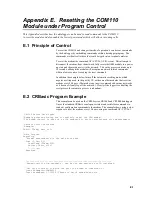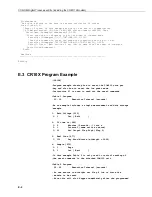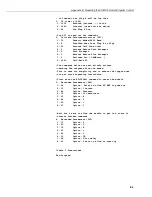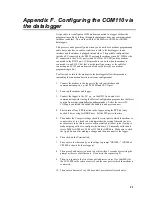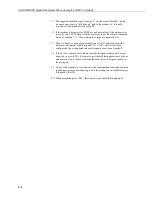
Appendix F. Configuring the COM110 via
the datalogger
It is possible to reconfigure a GSM modem connected to a logger without the
programming cable by talking through the datalogger from one communications
interface to another. This works with the CR800 series, CR1000 or CR3000
dataloggers.
This process can be generally used when you do not have a modem programming
cable but you do have a cable or interface to talk to the datalogger via one
interface and the modem is plugged into another. The possible configurations
include a PC connected to the RS232 port and the modem via an SC-WMI or the
PC connected to the CS I/O port (via an SC32B or SC-USB) and the modem
connected to the RS232 port. (This procedure can work when the modem is
connected via an SC105, but that is not normally necessary as the cable for
connecting an SC105 and modem can also be used directly as a modem
programming cable.)
To allow you to talk to the modem via the datalogger follow this procedure
(amending the connection details to suit your configuration).
1.
Connect the modem to the logger via the relevant interface and
communications port, e.g. the SC-WMI and CS I/O port.
2.
Power up the modem and logger.
3.
Connect the logger to the PC, e.g. via the RS232 port, and start
communicating with it using the Device Configuration program (use the latest
version from www.campbellsci.com/downloads ). Select the correct PC
COM port you intend to use and the baud rate and press connect.
4.
First to turn off any PPP function in the logger, using the PPP tab (only
needed if it was setup for GPRS use). Set the PPP port to inactive.
5.
Then under the Comport settings check the serial port to which the modem is
connected is set to a baud rate which matches the setup of the modem (it is
not necessary to do this to receive calls normally but is best to do if trying to
make outgoing calls or to configure the modem). CS normally set the baud
rate to 9600 for GSM use, 9600 or 115200 for GPRS use. Make sure to click
the Apply button after making a change and then reconnect to the logger.
6.
Then click on the Terminal tab.
7.
Press enter a few times and you should get a prompt “CR1000>” (CR800 or
CR3000 is shown for those loggers).
8.
Then press P and enter (you need to do this within 3 seconds of receiving the
prompt as there is a fast timeout). If you miss this repeat step (7).
9.
Then, in response to the list of com port addresses, enter 2 for ComME (for
the SC-WMI) or the relevant entry to suit the com port to which the modem is
connected.
10.
Then enter a timeout of say 300 (seconds), press enter after each entry.
F-1











